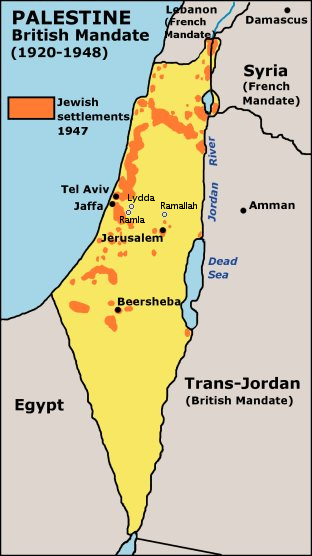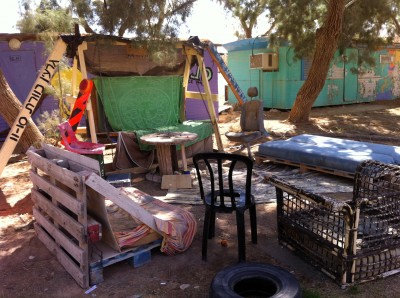I
My stepfather always told me that all the best books have maps. So when I opened Ari Shavit’s My Promised Land: The Triumph and Tragedy of Israel a map was the first thing I looked for. I found it on the first page of the book, just after the title page and the dedication. The map shows Israel and the lines of two routes: those of Ari Shavit and of his great-grandfather, Herbert Bentwich. A columnist and member of the Haaretz editorial board, Ari Shavit travels in the footsteps of his great-grandfather examining not only the land and people of Israel today, but also the stark realities, sometimes beautiful, sometimes terrible, of its creation. He succeeds in creating an unbiased narrative of both Israel and Zionism.
In my mind, I compare these journeys to my own exploration of Israel in 2012. I spent just under a year in Israel. I started in Jerusalem, then moved to a suburb of Tel Aviv, then to Kibbutz Ketura just north of Eilat. In addition, I took many day and weekend trips to Masada, Haifa, and Lake Tiberias. My trip to Israel was with a program sponsored by a Zionist youth group, Young Judaea.
During my first seven months, in Jerusalem and Tel Aviv, I volunteered and took classes. The classes covered comparative religions, Israeli Film and Society, issues in Modern Orthodox thought and of course Hebrew ulpan, an intensive, immersive Hebrew course. I thoroughly enjoyed most of my classes with the exception of one: the History of Zionism.
What worried me was the one-sided view I was getting of Israel’s history. One-sided history also worries Ari Shavit. Though a thorough defender of Israel, he does not sugarcoat what the Israelis have done to build their country.
II
I traced my own journey with my finger over the map in My Promised Land. I went from east to west and then finally south; the opposite route of Herbert Bentwich. In 1897, Herbert Bentwich led a pilgrimage to Israel. Thirty people made the journey with him, twenty-one of them Zionist pilgrims. They travelled from London, Marseille, Paris, and Alexandria. Bentwich was British and wealthy – a believer rather than a secularist Zionist. Bentwich, noting the secularization of the Jews in both Europe and America, felt that “Palestine is to be a Jewish home that will ensure Jewish salvation.”
I paused after reading these first few paragraphs of My Promised Land and remembered what I learned in the History of Zionism and Israel. This sounded like the typical, mystical Zionism that I was taught. Then I read on. Unlike my course, Shavit points out flaws in the Zionist ideal. He notes that Bentwich takes no notice of the Arab, Bedouin, and Druze whom he sees, possibly as a result of his high standing as a white, British national of means.
From Herbert Bentwich in 1897, Ari Shavit moves on to Kibbutz Ein Harod, which, founded in 1921, was Israel’s first kibbutz. The kibbutz has modest roots: a handful of Labor Brigade comrades in their early twenties. “The move is not only brilliant, it is brave. The young Labor Brigade comrades settling in the Valley of Harod do not ask themselves how the eighty thousand Jews living in Palestine in 1921 will deal with more than six hundred thousand Arabs…Like Herbert Bentwich, the seventy-four Ein Harod pioneers are blessed and cursed with convenient blindness.” Four months later, Yitzhak Tabenkin, prominent leader of the labor movement, joined Ein Harod in December 1921. With Tabenkin came a small group of people to dig canals to disseminate water to dry areas and thin the morass of swampland. On its first anniversary, Kibbutz Ein Harod is able to celebrate its hard work and success. Ari Shavit makes it clear that kibbutz socialism was essential to the founding of the State of Israel. The romanticism and idealism of the kibbutz socialist mentality enabled Zionism to settle the valley and then the Land.

With these first two chapters, about Bentwich and Ein Harod, Shavit lays the groundwork for the rest of the book. In his telling of Israeli history, Shavit chooses to zoom in on stories of individuals. There are no broad chapters on the Six Day War or the Yom Kippur War. The chapter set in 1948 is not about the founding of the State of Israel, instead it is about the Lydda valley, home of the city of Lod 9 miles outside Tel Aviv, what Ari Shavit calls the “dark secret of Zionism.”
The 1948 chapter opens with failure. In 1903, Nahum Wilbosh built his Atid (Hebrew for “future”) factory in the Lydda valley with the intention of pressing oil and manufacturing soap, but it collapsed just before WWI. In 1904, Israel Belkind built Kiryat Sefer, an agricultural school for the orphans of the Kishinev pogrom, on the Lydda valley’s Ben Shemen estate. He spent 43,000 Francs to purchase the land and erect classrooms and dormitories only to find himself short of the funds necessary to run the school. In 1908, four years after Theodor Herzl’s death, the Zionist movement planted a thousand the olive trees to commemorate its founder. In addition to the new trees, the old Arab olive groves of Lydda were uprooted and replanted to signify the efficacy of Jewish hands working the same soil. Soon after, war and pestilence destroyed the olive groves in their entirety.
In 1925, Dr. Siegfried Lehmann finally succeeded in the valley of Lydda. Dr. Lehmann came to the valley to escape European anti-Semitism and to open a youth village. The village, settled in Ben Shemen, prospered. He and the children were well-liked by the Arab residents, even providing medical care for them.
As 1947 approached, “the people of Lydda did not see that the Zionism that came into the valley to give hope to a nation of orphans [had] become a movement of cruel resolve, determined to take the land by force,” says Shavit. In February 1947, England, fed up with the Arab-Jewish conflict, allowed the UN to decide the fate of Palestine. Dr. Lehmann saw Lydda and the youth village as a microcosm of what Zionism should be: Arabs and Jews living peacefully side by side. That was until December 1947 when a convoy headed to Ben Shemen was attacked, leaving thirteen of its Jewish passengers murdered. After that, the Lydda valley became a war zone. Four hundred students of Ben Shemen were evacuated in buses, accompanied by British armored vehicles. In just two months, Ben Shemen was converted into a besieged military post.
On May 15, 1948, the day after the State of Israel was founded, the armies of Egypt, Iraq, Jordan, Syria and Lebanon invade and a full-scale war began. A few weeks after, David Ben Gurion, Israel’s first Prime Minister, was presented Operation Larlar, designed to conquer Lydda. On July 10, the Lydda valley was taken from the north and south. “Within twenty-four hours of the Israeli Army’s first division-scale offensive, all the villages Dr. Lehmann so loved and taught his students to love was conquered. And as Zionism [closed] in on the valley of Lydda from the south, east, and north, it now [prepared] to conquer the city of Lydda itself.” Lydda was conquered in just a few hours. Forty-seven minutes of blitz allowed two 3rd Regiment platoons to penetrate the city and confine thousands of citizens in two mosques and a cathedral. The next day they were deported.
“Zionism [obliterated] the city of Lydda,” writes Ari Shavit. Throughout the Lydda chapter, Shavit echoes back to Ben Shemen and Dr. Lehmann’s ideal Zionism. Even when Shavit puts the reader on the front lines of the blitz of Lydda, he harkens back to Ben Shemen: “By the water fountain Dr. Lehmann built for his Arab neighbors, Moshe Dayan forms [Regiment 89] into an armored column…the column leaves Ben Shemen and speeds into the city of Lydda, firing at all in its way.” This is a crucial moment in the book where Ari Shavit acknowledges the atrocity of Lydda but will not join the bleeding-heart liberals in mourning:
“I will not damn the brigade commander and the military governor and the training group boys. On the contrary. If need be, I’ll stand by the damned. Because I know that if it wasn’t for them, the State of Israel would not have been born,” he writes. “They did the dirty, filthy work that enables my people, myself, my daughter and my sons to live.”
In telling the lesser known stories, Ari Shavit shows that Israel is a land of its people. Israel is not just his promised land; every Israeli has a personal connection to the land. Shavit knows Israel intimately and loves Israel without equivocation. The importance of My Promised Land is the broad scope with which Ari Shavit narrates the history of Israel. Leon Wieseltier, literary editor of The New Republic, was correct when he wrote, “It is a Zionist book unblinkered by Zionism. It is about the entirety of the Israeli experience.”
Ari Shavit both acknowledges its success and lays bare its failure. His love for Israel seeps through every sentence, yet Ari Shavit unearths the skeletons buried in Lydda just as unflinchingly as he revels in the hope inspired by their cooperation with Ben Shemen before their deaths. He is staunchly Zionist; Israel is a nation, a fact. However, he does not use propaganda to get his point across. He does not romanticize Zionism and fully recognizes the duality of the problem. He is sympathetic to both sides of the issue at hand. “I am no judge. I am an observer…I choose not to zoom in on the single dimension of Jew and Arab, us and them, Israel and its other.” For me, Shavit’s advice is worth taking.
III

I spent my last four months in Israel as a volunteer on Kibbutz Ketura. Just a few miles north of Eilat, Kibbutz Ketura is also home to the Arava Institute, an environmental studies and research program accredited through Ben Gurion University. My days started early, waking up at 5am to work either in the kitchen, setting up for events, or in the laundry. My work would end around 2, when the sun was at its strongest. From there my friends and I would meet at the “living room,” a colorful assortment of lawn chairs, overturned buckets and an old mattress and plywood fashioned into a swing.
There the kibbutz volunteers and students of the Arava Institute would smoke hookah, build bonfires, and mostly tell stories over a few beers. It wasn’t until I asked one of the students about the school that I learned that the Arava Institute’s student body is comprised of Israelis, Palestinians, and Jordanians. Sitting there, hookah nozzle being passed from person to person, there was no animosity; we didn’t judge people by their backgrounds. The students of the institute were all there for a common purpose: to use their knowledge to better Israel. I think back on my kibbutz experience and recall Dr. Lehmann and Ben Shemen. Dr. Lehmann’s ideal Zionism is not lost.
Alex E. Lipton is a student at Sarah Lawrence College.

